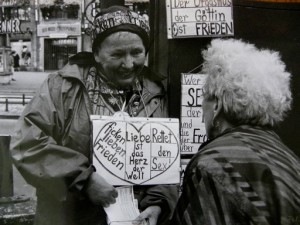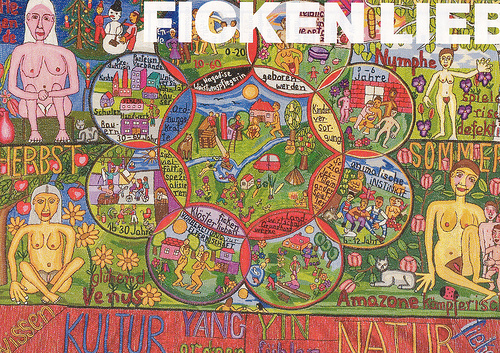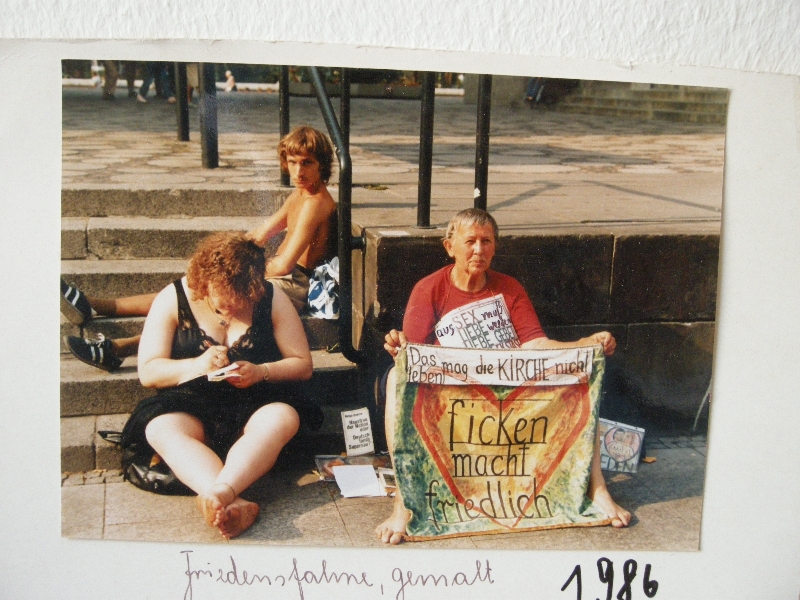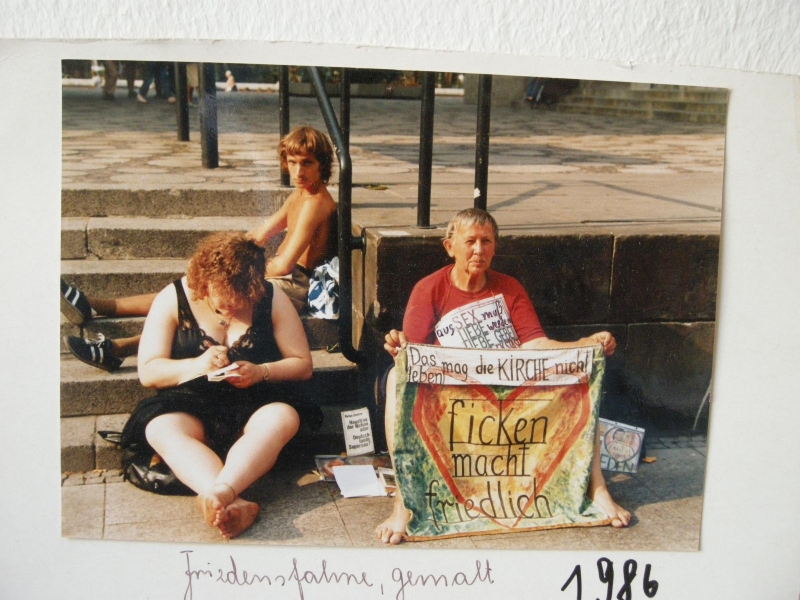Helga Sophia GoetzeHelga Sophia Goetze
 Nasce a Magdeburg (Germania) nel 1922 e cresce in una famiglia borghese. All’età di 20 anni, si sposa con un uomo 12 anni più grande e alcuni anni dopo si trasferisce ad Amburgo, dove il marito ricopre un’alta carica nella Deutsche Bank. Avranno insieme ben sette figli, cinque femmine e due maschi. Durante un viaggio in Sicilia conosce Giovanni che, con il consenso di suo marito, diventerà il suo amante. Questa prima e decisiva esperienza la conduce ad un cambiamento esistenziale: rompere con la sua ‘protetta realtà di casalinga’ per indagare, tramite una sessualità aperta, sulla repressione ed i tabù a cui è assoggettata la società moderna. Comincia a scrivere per il giornale del quartiere St. Paulinus per trovare nuovi partners. Suo marito chiede il divorzio, lei abbandona la casa e fonda una WG (appartamento condiviso da più persone che scelgono di vivere assieme), dove si pratica una vita sessuale libera. Nel 1978 si trasferisce a Berlino nel quartiere Kreuzberg. Dagli inizi degli anni ‘80, la Goetze crea un’enorme e affascinante universo di quadri a ricamo, ma diventa nota soprattutto per una continuativa veglia di protesta alla Gedächtniskirche di Berlino. Per oltre vent’anni, ogni giorno si reca davanti alla chiesa per manifestare il suo messaggio: “Scopare rende pacifici” – “Scopare e’ Pace”. Artista prolifica, scrive più di tremila poemi, e realizza più di trecento quadri a ricamo tessendo una sua mitologia del desiderio. All’inizio scrive tutto quello che le succede attorno, annota anche le conversazioni telefoniche, poi le trascrive con carta carbone e le spedisce ogni giorno a dieci, quindici amici. Successivamente auto-produce i suoi libri. Non si è mai considerata un’artista ma ‘una casalinga che vuole capire gli intrecci della vita’. Dal 1982 fino alla sua morte avvenuta il 29 gennaio 2008, ha vissuto nel quartiere Charlottenburg, in Schlüterstrasse 70 Gartenhaus, dove aveva affisso sulla facciata dell’abitazione, una targa d’ottone che diceva: HSG, Geni(t)ale Università, Insegnamento e ricerca, aperto ogni giorno dalle ore 17 alle ore 19. Nel 2007 con la sua ultima esposizione dal titolo ‘Cos’e’ una donna? Percorso di una Partenza’ nella galleria Studiogalerie des Haus am Lützowplatz di Berlino, Helga ottiene un primo vero riconoscimento come artista. Nello stesso anno la Collection dell’Art Brut di Losanna acquista cinque grandi ricami che inserisce nella propria collezione.
Nasce a Magdeburg (Germania) nel 1922 e cresce in una famiglia borghese. All’età di 20 anni, si sposa con un uomo 12 anni più grande e alcuni anni dopo si trasferisce ad Amburgo, dove il marito ricopre un’alta carica nella Deutsche Bank. Avranno insieme ben sette figli, cinque femmine e due maschi. Durante un viaggio in Sicilia conosce Giovanni che, con il consenso di suo marito, diventerà il suo amante. Questa prima e decisiva esperienza la conduce ad un cambiamento esistenziale: rompere con la sua ‘protetta realtà di casalinga’ per indagare, tramite una sessualità aperta, sulla repressione ed i tabù a cui è assoggettata la società moderna. Comincia a scrivere per il giornale del quartiere St. Paulinus per trovare nuovi partners. Suo marito chiede il divorzio, lei abbandona la casa e fonda una WG (appartamento condiviso da più persone che scelgono di vivere assieme), dove si pratica una vita sessuale libera. Nel 1978 si trasferisce a Berlino nel quartiere Kreuzberg. Dagli inizi degli anni ‘80, la Goetze crea un’enorme e affascinante universo di quadri a ricamo, ma diventa nota soprattutto per una continuativa veglia di protesta alla Gedächtniskirche di Berlino. Per oltre vent’anni, ogni giorno si reca davanti alla chiesa per manifestare il suo messaggio: “Scopare rende pacifici” – “Scopare e’ Pace”. Artista prolifica, scrive più di tremila poemi, e realizza più di trecento quadri a ricamo tessendo una sua mitologia del desiderio. All’inizio scrive tutto quello che le succede attorno, annota anche le conversazioni telefoniche, poi le trascrive con carta carbone e le spedisce ogni giorno a dieci, quindici amici. Successivamente auto-produce i suoi libri. Non si è mai considerata un’artista ma ‘una casalinga che vuole capire gli intrecci della vita’. Dal 1982 fino alla sua morte avvenuta il 29 gennaio 2008, ha vissuto nel quartiere Charlottenburg, in Schlüterstrasse 70 Gartenhaus, dove aveva affisso sulla facciata dell’abitazione, una targa d’ottone che diceva: HSG, Geni(t)ale Università, Insegnamento e ricerca, aperto ogni giorno dalle ore 17 alle ore 19. Nel 2007 con la sua ultima esposizione dal titolo ‘Cos’e’ una donna? Percorso di una Partenza’ nella galleria Studiogalerie des Haus am Lützowplatz di Berlino, Helga ottiene un primo vero riconoscimento come artista. Nello stesso anno la Collection dell’Art Brut di Losanna acquista cinque grandi ricami che inserisce nella propria collezione.
 She was born in Magdeburg (Germany) in 1922. She grew up in a well-to-do family. At the age of 20 she got married to a man who was 12 years older than her and some years later she moved to Hamburg: her husband was part of the managerial staff of Deutsche Bank. They had as many as seven children. Five daughters and two sons. During a journey to Sicily, she met Giovanni who, with the consent of her husband, became her lover. This first and decisive experience led her to a change in her life: she broke with her “protected housewife life” to investigate, through open sexuality, the subjugations and taboos to which modern society was subject. She began to write for the newspaper of the district St. Paulinus, in order to find new partners. Her husband sought divorce; she quitted home and founded a WG (a flat shared by more people who have decided to live together), based on sexual liberty. In 1978 she moved to Berlin, in the area of Kreuzberg. From the beginning of the ‘80s, Goetze began to create a vast and awesome universe of embroideries. But she is mostly renowned for her continuous protest watch in front the Gedächtniskirche. For more than twenty years, every day, she has demonstrated in front of the church, showing her message: “Fucking makes people peaceful” – “Fucking is peace”. As a prolific artist, she has written more than three thousand poems and accomplished more than three hundred embroideries, weaving her own mythology of desire. At the beginning, she wrote about what happened around her. She also used to take notes of her telephone conversations, write them out using carbon paper and send them every day to ten, fifteen friends. She self-produced her books. She has never considered herself an artist, but only a “housewife who has tried to understand the plot of life.’ From 1982 to her death, on January 29 2008, she lived in Schlüterstrasse 70 Gartenhaus, in the Charlottenburg district. On the front of her house she had hung a brass plate reading: HSG, Geni(t)al University, Lessons and research, open daily from 5pm to 7pm. Helga obtained her first acknowledgement as an artist in 2007, with her last exhibition titled: ‘What a woman is? The pathway of a Departure’ at the Studiogalerie des Haus am Lützowplatz in Berlin. The same year, the Collection del’Art Brut of Lausanne purchased five big embroideries, which became part of their collection.
She was born in Magdeburg (Germany) in 1922. She grew up in a well-to-do family. At the age of 20 she got married to a man who was 12 years older than her and some years later she moved to Hamburg: her husband was part of the managerial staff of Deutsche Bank. They had as many as seven children. Five daughters and two sons. During a journey to Sicily, she met Giovanni who, with the consent of her husband, became her lover. This first and decisive experience led her to a change in her life: she broke with her “protected housewife life” to investigate, through open sexuality, the subjugations and taboos to which modern society was subject. She began to write for the newspaper of the district St. Paulinus, in order to find new partners. Her husband sought divorce; she quitted home and founded a WG (a flat shared by more people who have decided to live together), based on sexual liberty. In 1978 she moved to Berlin, in the area of Kreuzberg. From the beginning of the ‘80s, Goetze began to create a vast and awesome universe of embroideries. But she is mostly renowned for her continuous protest watch in front the Gedächtniskirche. For more than twenty years, every day, she has demonstrated in front of the church, showing her message: “Fucking makes people peaceful” – “Fucking is peace”. As a prolific artist, she has written more than three thousand poems and accomplished more than three hundred embroideries, weaving her own mythology of desire. At the beginning, she wrote about what happened around her. She also used to take notes of her telephone conversations, write them out using carbon paper and send them every day to ten, fifteen friends. She self-produced her books. She has never considered herself an artist, but only a “housewife who has tried to understand the plot of life.’ From 1982 to her death, on January 29 2008, she lived in Schlüterstrasse 70 Gartenhaus, in the Charlottenburg district. On the front of her house she had hung a brass plate reading: HSG, Geni(t)al University, Lessons and research, open daily from 5pm to 7pm. Helga obtained her first acknowledgement as an artist in 2007, with her last exhibition titled: ‘What a woman is? The pathway of a Departure’ at the Studiogalerie des Haus am Lützowplatz in Berlin. The same year, the Collection del’Art Brut of Lausanne purchased five big embroideries, which became part of their collection.



